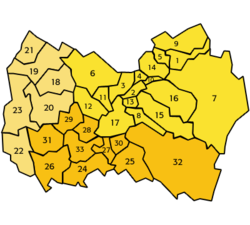O'Higgins Region
This article needs additional citations for verification. (January 2009) |
Libertador General
Bernardo O'Higgins Region Región del Libertador General Bernardo O'Higgins | |
|---|---|
 Río Claro | |
 Map of Libertador General Bernardo O'Higgins Region | |
| Coordinates: 34°10′02″S 70°43′37″W / 34.16722°S 70.72694°W | |
| Country | |
| Capital | Rancagua |
| Provinces | Cachapoal, Colchagua, Cardenal Caro |
| Government | |
| • Presidential Regional Delegate | Fabio López (Independent) |
| • Governor | Pablo Silva Amaya |
| Area | |
| • Total | 16,387.0 km2 (6,327.1 sq mi) |
| • Rank | 14 |
| Lowest elevation | 0 m (0 ft) |
| Population (2017)[1] | |
| • Total | 908,545 |
| • Rank | 6 |
| • Density | 55/km2 (140/sq mi) |
| GDP (PPP) | |
| • Total | $16.376 billion (2014) |
| • Per capita | $17,985 (2014) |
| ISO 3166 code | CL-LI |
| HDI (2019) | 0.820[3] very high |
| Website | goreohiggins |
The Libertador General Bernardo O'Higgins Region
The Libertador General Bernardo O'Higgins Region is bordered to the west by the Pacific Ocean, to the east by the Republic of Argentina, to the north by the Valparaíso and Santiago Metropolitan Regions, and to the south by the Maule Region. It extends approximately between the parallels of 33° 51' and 35° 01' south latitude, and between the meridian of 70° 02' west longitude and the Pacific Ocean.
The capital and largest city of the region is Rancagua. The second major town is San Fernando.
Geography

In pre-Quaternary times extensive Nothofagus forests covered much of Libertador General Bernardo O'Higgins Region.[8]
The Libertador General Bernardo O'Higgins Region is part of the very restricted range of the
History
From 9000
Demography

The Libertador General Bernardo O'Higgins region contains a large part of the rural population (surpassed only by the
Economy
The main industrial and export activity takes place at CODELCO's El Teniente mine, which contributes 7.7% of Chile's copper production. The ore is processed at the Sewell and Colón concentrator plants, smelted and refined at Caletones, and shipped from the port of San Antonio, in the Valparaíso Region. Byproducts include molybdenum and silver.
Agriculture contributes 30.1% of the region's GDP. One out of every four hectares of fruit orchards in Chile is in the Libertador General Bernardo O'Higgins Region. The main crops are apples and pears, followed by table grapes, plums, kiwis, and nectarines.
Manufacturing activity in the region is mostly related to
Over the past few years, there has been significant development in the forestry sector, especially plantations of eucalyptus and radiata pine.
Law and government
The region is co-governed by a presidential regional delegate, who is appointed by the president —currently independent Fabio López— and popularly-elected governor of O'Higgins, Pablo Silva Amaya, who was elected in 2021 and will serve until 2025. [11]
The administration of the region rests with the regional government which is headed by the regional governor and the regional council (Consejo Regional de Chile). The latter comprises twenty regional council members, who are popularly elected since 2013 (thirteen from Cachapoal, five from Colchagua, and two from Cardenal Caro).
Administrative divisions
For purposes of interior administration, the Libertador General Bernardo O'Higgins Region is divided into three provinces:
- Cachapoal Province, capital: Rancagua,
- Colchagua Province, capital: San Fernando,
- Cardenal Caro Province, capital: Pichilemu.
The provinces are subdivided into 33

|
Education
Culture
This area is known as the "huaso province" after the name of the Chilean cowboy, the
The population is a mixture of both European (including
The Libertador General Bernardo O'Higgins Region was settled by Spaniards (notably
Regional festivals
| Date | English Name | Spanish Name | Notes |
|---|---|---|---|
| 1–2 October | Disaster of Rancagua | Desastre de Rancagua | In memory of the Battle which occurred in 1814
of Rancagua |
Notable people
- Violeta Zúñiga (1933–2019), human rights activist
References
- ^ Government of Chile Foreign Investment Committee. Retrieved 13 March 2010.[permanent dead link]
- ^ Regions and Cities > Regional Statistics > Regional Economy > Regional GDP per Capita, OECD.Stats.
- ^ "Subnational Human Development Index". Retrieved 26 October 2021.
- ISSN 0718-5839.
In the dryland of the Libertador General Bernardo O'Higgins Region in Chile, most farmers rely [...]
- ISBN 9780877795469. Retrieved 26 July 2012.)
Rancagua. City of Libertador General Bernardo O'Higgins Region.
{{cite book}}:|last=has generic name (help - ISBN 9780844408286. Retrieved 26 July 2012.
[...] the provinces of San Felipe de Aconcagua, Colchagua and Valparaíso, as well as Libertador General Bernardo O'Higgins Region and [...]
- ^ "Decreto Ley 2339. Otorga denominación a la Región Metropolitana y a las regiones del país, en la forma que indica". Ley Chile (in Spanish). Biblioteca del Congreso Nacional de Chile. 10 October 1978. Retrieved 26 July 2012.
- ISBN 0-300-06423-3
- ^ C. Michael Hogan (2008) Chilean Wine Palm: Jubaea chilensis, GlobalTwitcher.com, ed. Nicklas Stromberg Archived 17 October 2012 at the Wayback Machine
- ^ "Chile: Proyecciones y Estimaciones de Población. Total País 1950–2050" Instituto National de Estadísticas (INE)
- ^ https://www.goreohiggins.cl/gobernador-regional
External links
- "The Libertador Bernardo O'Higgins Region" at the Chilean government website (in Spanish)
- Regional government of the O'Higgins Region (in Spanish)
- VI.cl: Portal de la Sexta Región (Portal for the Sixth Region) (in Spanish)
- Pichilemu's official website (in Spanish)
- . Collier's New Encyclopedia. 1921.
- . New International Encyclopedia. 1905.




